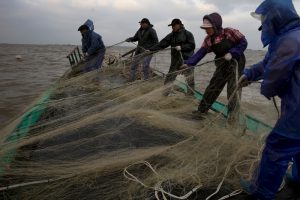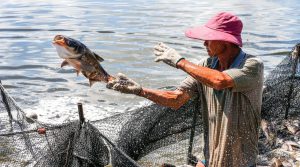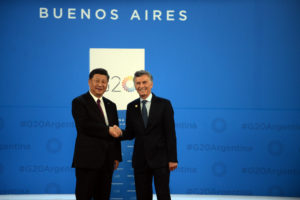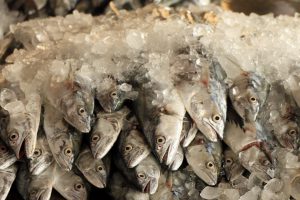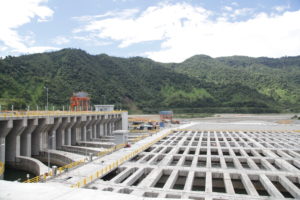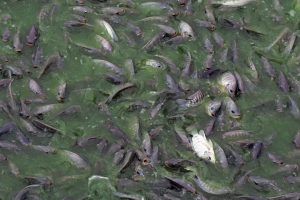Marcy Trent Long: Hi! My name is Marcy Trent Long. Welcome to Sustainable Asia. 1986 is made in collaboration with China Dialogue. It’s a four-part podcast series about China, oceans and fish.
This is episode four of 1986 – a story of how China is breaking the cycle of overfishing that was unleashed with the passage of the 1986 Fisheries Law during their reform and opening period.
Previously, on episode three…
Cao Ling: Starting from 2020, fishing will be completely banned in the Yangtze River for 10 years.
John Mimikakis: China’s leaders recognise that overfishing is a problem. Top leaders today in China are pushing for a number of improvements in managing fisheries sustainably.
Marcy: In 1986, China passed a fisheries law that privatised fishing vessels and moved China from a country of wooden boat fishing communes into the modern world of mechanised, commercial fishing trawlers. Now, China is by far the biggest producer and consumer of fish products globally. And since 2002, China’s been the world’s leading exporter of fish products. China’s fishing industry, however, is increasingly the victim of its own success.
In 2013, China spent US$6.5 billion on fishing subsidies – the fuel subsidies that we described in episode two. Many countries still have these types of fishing subsidies, and until they’re gone, overfishing problems may well persist. But as Songlin Wang, China programme director of Ocean Outcomes, told us in episode three, fisheries development in China is now moving towards a type of mariculture called “marine ranching”.
John: So I’m an ocean conservationist at the Environmental Defense Fund. My name’s John Mimikakis and I lead our effort to make oceans sustainable in Asia. So overfishing is not the only challenge threatening China’s marine fisheries. There’s also been serious habitat loss. And while the Chinese people have enjoyed astonishing economic development over the last 40 years, the environmental costs have also been staggering. More than 50% of coastal wetlands have been lost, 57% of mangroves, and 80% of coral reefs gone. These habitats were once critical to the lifecycle of many species found in China’s waters. They provide feeding grounds, spawning grounds, nursery grounds and over-wintering habitats. So while preventing overfishing is part of the solution, China really needs to undertake massive habitat restoration and renovation to restore these critical ecosystem functions.
Marcy: Enter marine ranching…
John: When I talk to Chinese scientists, they talk about marine ranching to include everything from planting seagrasses and creating artificial reefs, as well as things like restocking the ocean with fingerlings and baby fish. I think there are a lot of potential challenges with marine ranching, but it’s possible that marine ranching in China could be one way to restore habitats and ecosystem functions that could help rebuild healthy and abundant wild fish populations.
Marcy: Marine ranching is a type of aquaculture that was first developed in the 1970s. The goal was the same back then: bring back ocean fish species with man-made “artificial reefs” on the ocean floor. But the methods were a bit more primitive: sinking old boats, dropping concrete slabs and even submerging old subway cars. Whatever it would take to encourage the algae to grow or change seabed currents is what people did. Today in China, the approach is a bit more scientific.
Zhang Chun: The construction of marine ranching has two purposes. The first is to restore our fishery resource, and the second is to recover our offshore environment, because overfishing in China has been very serious in the past few decades.
Marcy: Zhang Chun is editor of chinadialogueocean in Beijing. She received a master’s degree in geographic sciences and natural resources research at the Chinese Academy of Sciences.
Zhang Chun: The Ministry of Agriculture actually has a plan, so at this time last year, there were about 200 big and small marine ranches and about 42 national marine ranching pilots along the [east] coast of China. From north to south, basically all provinces have it, but there are more located in the north, especially in Liaoning and Shandong.
Marcy: The water in the north is calmer and shallower, whereas the water in the south is deeper and rougher, so marine ranching varies along the coast of China. Tian Tao, a professor at Dalian University, has spent years studying the ecology of artificial reefs and fish behaviour.
Tian Tao: The pilots from north to south have different construction goals and plans. In the north, because many of the sea areas are contracted to private sectors of the government, the main construction model is to construct artificial reefs and to raise shellfish, including sea cucumbers, sea urchins and abalone. This seafood has high economic value and can be retrieved easily, so the companies can earn profits. But in the south, most marine ranches are not for profit, and the government operates and manages the ranches. The main goal of these ranches is for rehabilitation purposes, to recover the ocean habitat. The artificial reefs used here in the south tend to be bigger compared to the ones in the north, and serve as protection for fish.
Marcy: Artificial reefs are used to mimic natural reefs as homes for fish and marine organisms. But will just building artificial reefs be enough?
Sun Bin: The construction of marine ranches needs to include releasing juvenile fish, but releasing them inside the ranching areas is not necessary. We release the fish to increase the amount of general fish capacity.
Marcy: That was Sun Bin, a professor at Shanghai University. He has a doctoral degree in aquatic biology from South Korea, where he studied and worked in marine ranching.
Sun Bin: Releasing juvenile fish is carried out by national-level farms, provincial-level farms and some fisheries research institutes. The fish that are released for the public good are usually high-economic-value fish. Fish are also released to increase ocean biodiversity, since it has been pretty depleted.
Marcy: The 13th Five Year Plan for the national marine economy in China calls for the sustainable development of regional ocean fisheries, primarily through marine ranching pilot programmes. But is building artificial reefs sustainable development for the ocean?
Sun Bin: Artificial reefs are a very important part of marine ranching, but they are not always essential. From the perspective of ecology, we want to have the least human intervention possible when we repair or restore the habitat of a sea area. By placing artificial reefs, it will have certain impacts on the benthic organisms – small organisms that live in the ocean floor sediment – and it will change the geographic makeup of the seabed. But the main problem of placing artificial reefs is the material that it is made of, which is concrete, and without proper treatment, can affect the pH balance of the sea.
Marcy: According to chinadialogue, by 2016, China had developed 850 square kilometres of marine ranches – an area about half the size of Beijing. China plans to invest around US$3 billion in the marine ranching pilot programmes under the new 13th Five Year Plan.
Sun Bin: Also the marine ranches today in China have somewhat deviated from their original purpose. In the beginning, it was designed to restore fishery capacity and recover the ocean environment, but by encouraging private ownerships, the goal shifted. As long as a corporate enterprise meets the criteria to receive funds from the government, they will build a marine ranch, and neglect the evaluation or assessment process. This is a short-term vision for the country. Currently only Shandong province has local standards for marine ranching. It regulates the construction area, depth, scale and whether it is for rehabilitation or leisure. But when it comes to determining what impact the artificial reef has on the environment, or if there should be a system in place to monitor and maintain the marine ranch – all these standards are missing in the whole country.
Wang Songlin: I think the one area I really worry [about] is that there are environmental impact assessments. The process is not transparent. There isn’t a chance for researchers in the environmental community, with different voices, to influence this procedure of the decision making. So that’s where I see the hidden risks. Although the desire from the central government is clear and is definitely eco-friendly.
Marcy: That was Songlin Wang, chairman of Qingdao Marine Conservation Society and China programme director of Ocean Outcomes. He graduated from the Ocean University of China, has a master’s from Yale University and has worked tirelessly on China ocean conservation issues for the last 15 years.
Wang Songlin: I think China needs more marine protected areas as many other countries do. And then this process like the artificial fish reef or marine ranching is also dependent right now on the leadership of the local provincial-level, local-level governments. So when some scientists were trying to propose [that a] newly-found seagrass bed needed to be set up as a reserve or protected area, they found that decision-makers were keen to turn this into a ranch.
Marcy: The 13th Five Year Plan for the national marine economy policy puts science and environmental protection first in the consideration of building marine ranches. Then the implementation of the new policy is handed down to the provincial and local level to assign and oversee the marine ranching permits. Bank loans and funding are also handed out at the local and provincial level. But there are inherent incentives for companies that have long-term marine ranch licences.
Wang Songlin: [If] they own the place for 15 years, let’s say, they certainly would have a much stronger desire to make sure they have a good harvest within the 15 years at least. Now they have the kind of incentive to make sure that they only harvest the sexually mature species etc. They may make more effort to conserve, for example, the breeding stocks.
Marcy: Countries like Japan and South Korea, who are more advanced in the technology of marine ranches – it makes me wonder if there’s anything that China could learn from them? Tian Tao again…
Tian Tao: Marine ranching is a good direction for China’s offshore waters due to serious damage and decline of marine habitat. In general we look at three areas: scientific planning, scientific construction and scientific management. In China, we start building marine ranching without a full understanding of it. In Japan and South Korea, they are more concerned about this part, and scientific planning comes before construction. Then after scientific planning is scientific construction, which we do pretty well here in China, and then the third part is scientific management. I visited Tongyeong Marine Ranching in South Korea two days ago. It was constructed 20 years ago, and they’ve been doing monitoring work every year since, but in China we rarely do so.
Marcy: So marine ranching in China has some opportunities, but it also has some challenges. Sun Bin again…
Sun Bin: I just want to say that in the future, whether it is to construct marine ranches inside or outside China, we should have a better scientific background to support it, and should not let it be owned by some business corporates. Because the ocean does not belong to just some corporates but all humans.
Marcy: Special thanks to our sponsors, the Swire Group Charitable Trust – creating positive change in education, marine and arts through supporting registered non-profit organisations, primarily in Hong Kong and mainland China.
1986 is produced by Sustainable Asia in collaboration with chinadialogue. The season was created and written by me, Marcy Trent Long. The assistant producer was Li-Ting Lin. Special thanks to Oscar Lee, John Mimikakis, Sam Bekemans, Jill Baxter and Zhang Chun. Carson and Kinsey Long created the 1986 graphic. And the intro and outro music is made from repurposed and recovered waste items by Alexander Mauboussin. Learn more about his music at kalelover.net.
Let’s not forget a warm thank you to our voiceovers: Kinsey Long, Annabat Martens, Ethan Chen and Andrew Suckley.
If you like what you hear, subscribe to the Sustainable Asia podcast. And please give us a rating.

